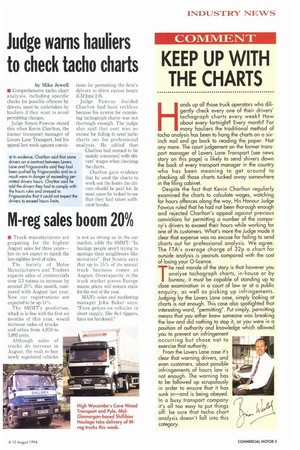KEEP UP WITH THE CHARTS
Page 7

If you've noticed an error in this article please click here to report it so we can fix it.
Hands up all those truck operators who dillgently check every one of their drivers' tachograph charts every week? How about every fortnight? Every month? For many hauliers the traditional method of tacho analysis has been to hang the charts on a sixinch nail and go back to reading the paper. Not any more. The court judgement on the former transport manager of Lovers Lane Transport (see news story on this page) is likely to send shivers down the back of every transport manager in the country who has been meaning to get around to checking all those charts tucked away somewhere in the filing cabinet. Despite the fact that Kevin Chariton regularly examined the charts to calculate wages, watching for hours offences along the way, His Honour Judge Fawcus ruled that he had not been thorough enough and rejected Charlton's appeal against previous convictions for permitting a number of the company's drivers to exceed their hours while working for one of its customers. What's more the Judge made it clear that expense was no excuse for failing to send charts out for professional analysis. We agree. The FTA's overage charge of 32p a chart for outside analysis is peanuts compared with the cost of losing your 0-licence. The real morale of the story is that however you analyse tachograph charts, in-house or by bureau, it must be capable of standing up to close examination in a court of law or at a public enquiry, as well as picking up infringements. Judging by the Lovers Lane case, simply looking at charts is not enough. This case also spotlighted that interesting word, "permitting". Put simply, permitting means that you either knew someone was breaking the law and did nothing to stop it, or you were in a position of authority and knowledge which allowed you to prevent art infringement occurring but chose not to exercise that authority. From the Lovers Lane case it's clear that warning drivers, and even customers, about possible infringements of hours law is not enough. The warning has to be followed up scrupulously in order to ensure that it has sunk in—and is being obeyed. In a busy transport company it's all too easy to put things off: be sure that tacho chart analysis doesn't fall into this category.






















































































